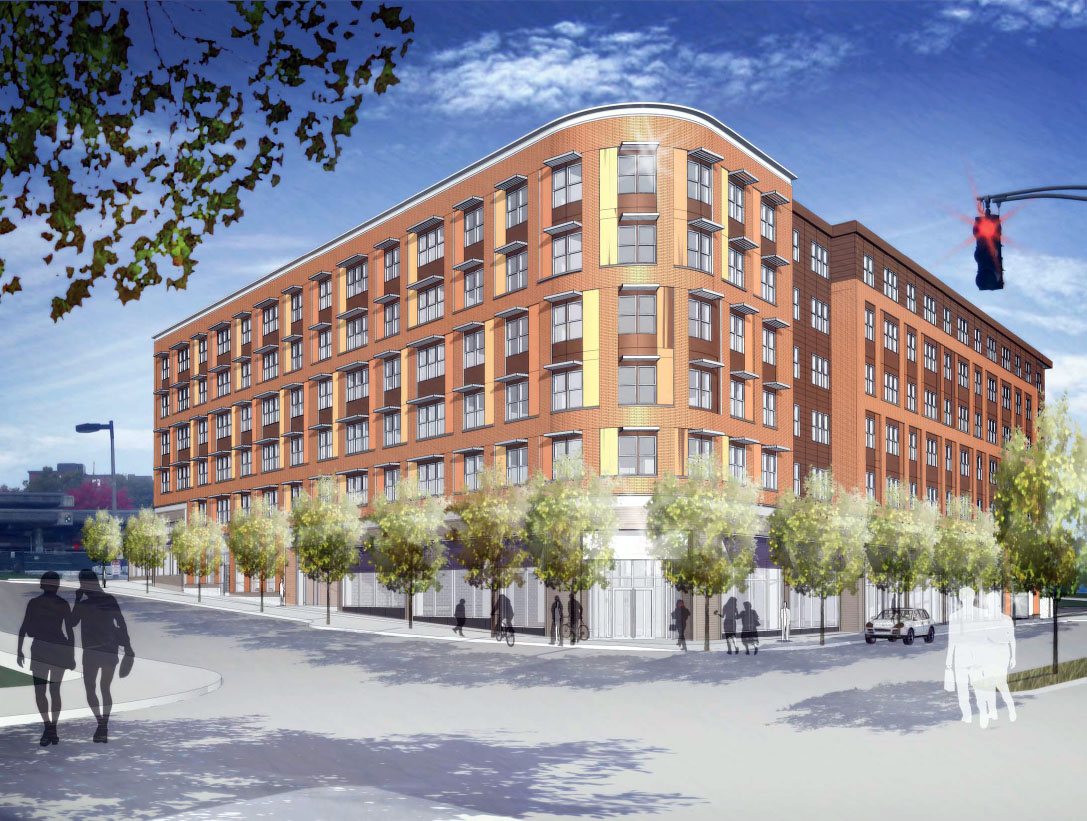 |
| Image Credit: The Community Builders, Inc. |
The 225 Centre Street project represents the first building in a $250M redevelopment plan featuring fourteen-buildings in the Jackson Square area of Boston's Jamaica Plain neighborhood. Like many ambitious redevelopment plans around Boston, the project- a joint venture between The Community Builders (TCB) and Mitchell Properties- is located in a community experiencing dramatic demographic shifts and the simultaneous tensions and benefits of three decades of gentrification. Unlike many other Boston redevelopment projects, 225 Centre is being built in an area of underutilized or vacant land- the product of preparations for a defeated highway extension proposal in the 1970s. The project is a mixed-use, mixed-income community of 103 rental units, 35 of which are marked as affordable for families below the poverty line and others reserved for "extremely low income" families. 225 Centre will also boast 16,000 square feet of commercial space and landscape improvements to the surrounding streetscape. 225 Centre came to our attention and kicks off this series following reasons:
1. Transit-Oriented Development
The need for affordable and mixed-income housing communities with access to public transportation to vibrant commercial centers, jobs, and services is a pressing concerns for affordable housing advocates and urban planners. 225 Centre is located adjacent to the Jackson Square station on the Orange Line of the T (Boston's subway system) and is at the convergence of several major bus routes, many of which link the development to downtown Boston. Additionally, the development provides easy access to the lovely SW Corridor Path, a pedestrian and bike-friendly greenbelt built on part of the proposed highway extension that links Jackson Square to the rest of Boston. In keeping with Boston's reputation as America's premier college town, public transit and the Corridor Path connects 225 Centre Street with nearby Northeastern University and Roxbury Community College, enhancing the potential for community access to these institutions and future partnerships.
2. Coordination with Community Groups
225 Centre and the larger fourteen building redevelopment effort is the result of close cooperation with community development corporations (CDCs) across Boston. TCB and Mitchell have worked with the Jamaica Plain Neighborhood Development Corporation, Urban Edge, and the Hyde Square Task Force to devise the projected master plan. The valuable input from these community organizations has led to a relationship that will allow for smart, sustainable growth benefitting both new residents and businesses at 225 Centre and current residents whose housing and commercial needs will be addressed by the project. As a result of dialogue between the developers and community groups, the fourteen buildings affiliated with the 225 Centre/Jackson Square project are expected to add 50,000 square feet of community facility space.
3. Return of Commercial Activity to Neighborhood
In addition to the development of mixed-income and affordable housing units, 225 Centre and affiliated projects have designated 60,000 square feer of retail and commercial space. This will allow neighborhood residents to have easy access to more goods and services previously only available outside the area or in short supply. Increased retail and commercial opportunities in Jackson Square will introduce additional jobs to the neighborhood and provide residents with more options at various price points as well as convenient access that may remove many prior barriers to obtaining these goods and services.
No comments:
Post a Comment